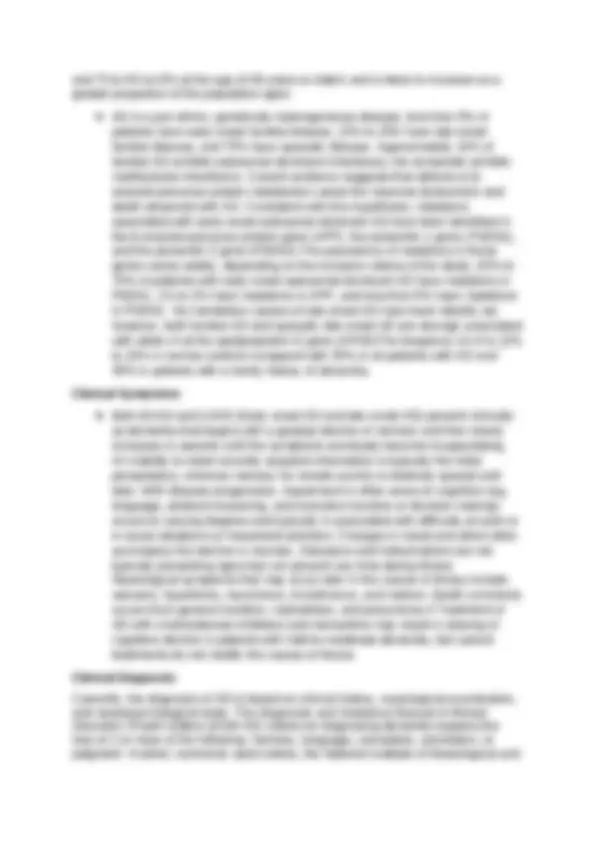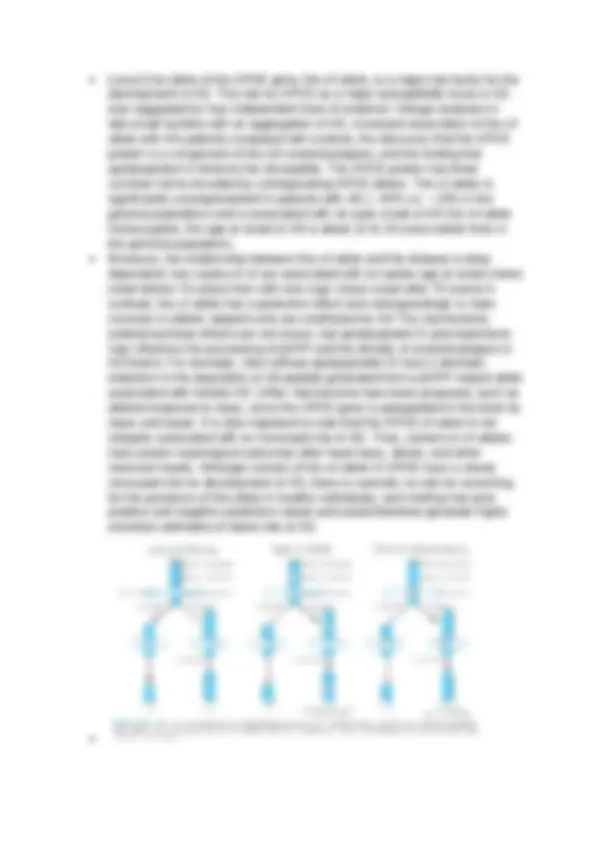








Study with the several resources on Docsity

Earn points by helping other students or get them with a premium plan


Prepare for your exams
Study with the several resources on Docsity

Earn points to download
Earn points by helping other students or get them with a premium plan
Community
Ask the community for help and clear up your study doubts
Discover the best universities in your country according to Docsity users
Free resources
Download our free guides on studying techniques, anxiety management strategies, and thesis advice from Docsity tutors
Case reports and discussion of the disease. Here 5 case reports were discussed and this is followed by detailed information of the disease.
Typology: Assignments
1 / 12

This page cannot be seen from the preview
Don't miss anything!







Case reports and explanation
Molecular biology and human genetics
Alzheimer’s disease : Case report 1 : L.W. was an elderly woman with dementia. Eight years before her death, she and her family noticed a deficit in her short-term memory. Initially, they ascribed this to the forgetfulness of “old age”; her cognitive decline continued, however, and progressively interfered with her ability to drive, shop, and look after herself. L.W. did not have findings suggestive of thyroid disease, vitamin deficiency, brain tumor, drug intoxication, chronic infection, depression, or strokes; magnetic resonance imaging of her brain showed diffuse cortical atrophy. L.W.’s brother, father, and two other paternal relatives had died of dementia in their 70s. A neurologist explained to L.W. and her family that normal aging is not associated with dramatic declines in memory or judgment and that declining cognition with behavioural disturbance and impaired daily functioning suggested a clinical diagnosis of familial dementia, possibly Alzheimer disease. The suspicion of Alzheimer disease was supported by her apolipoprotein E genotype: ε4/ε4. L.W.’s condition deteriorated rapidly during the next year, and she died of malnutrition at 82 years of age. Her autopsy confirmed the diagnosis of Alzheimer disease. Case report 2: The patient was referred to our specialty memory clinic at the age of 58 with a 2-year history of repetitiveness, memory loss, and executive function loss. Magnetic resonance imaging scan at age 58 revealed mild generalized cortical atrophy. She is white with 2 years of postsecondary education. Retirement at age 48 from employment as a manager in telecommunications company was because family finances allowed and not because of cognitive challenges with work. Progressive cognitive decline was evident by the report of deficits in instrumental activities of daily living performance over the past 9 months before her initial consultation in the memory clinic. Word finding and literacy skills were noted to have deteriorated in the preceding 6 months according to her spouse. Examples of functional losses were being slower in processing and carrying out instructions, not knowing how to turn off the stove, and becoming unable to assist in boat docking which was the couple’s pastime. She stopped driving a motor vehicle about 6 months before her memory clinic consultation. Her past medical history was relevant for hypercholesterolemia and vitamin D deficiency. She had no surgical history. She had no history of smoking, alcohol, or other drug misuse. Laboratory screening was normal. There was no first-degree family history of presenile dementia. Neurocognitive assessment at the first clinic visit revealed a Mini Mental State Examination (MMSE) score of 14/30; poor verbal fluency (patient was able to produce only 5 animal names and 1 F-word in 1 min) as well as poor visuospatial and executive skills.She had fluent speech without semantic deficits. Her neurological examination was pertinent for normal muscle tone and power, mild ideomotor apraxia on performing commands for motor tasks with no suggestion of cerebellar dysfunction, normal gait, no frontal release signs. Her speech was fluent with obvious word finding difficulties but with no phonemic or semantic paraphrasic errors. Her general physical examination was unremarkable without evidence of presenile cataracts. She had normal hearing. There was no evidence of depression or psychotic symptoms.
the Wechsler Memory scale, the Wechsler Adult Intelligence Scale, digit span and similarities subtests, the Boston Naming Test, the CERAD Word List Memory Test, the CERAD Visuo-spatial Construction, the Cross Circle Tests, the California Proverb Test, and the Graphomotor Alternation Test. She tended to perseverate both verbal and motor responses. The conclusion of the evaluation was that she met research criteria for "probable" Alzheimer's disease, that she required complete supervision around the clock to insure her safety, and that she would probably benefit from social stimulation provided by a group living situation. Case report 5: A 75-year-old woman who visited our hospital with her son due to her insistence that her bag had been stolen, but for around two years she had often misplaced her bag or purse. She had no history of psychiatric disorders. At the initial visit, no abnormal findings were found on routine blood tests, hematochemistry, or electroencephalography. Magnetic resonance imaging (MRI) of the brain showed no cerebrovascular damage, organic change, or striking atrophy. Her mini-mental state examination (MMSE) [6] score was 20 (orientation to time 2/5, orientation to place 2/5, registration 3/3, attention and calculation 5/5, recall 1/3, naming 2/2, repetition 1/1, following commands 3/3, reading 1/1, writing 0/1, and design copy 0/1). We gave a diagnosis of stage 4 AD (mild dementia) using the functional assessment staging (FAST) tool [7]. She was started on donepezil 5 mg/day and returned for follow-up visits with her son about once a month. Just over two years (26 months) after her first visit, she began to use elderly day care services and 17 months later she could not do simple calculations or shop alone. At five and a half years months after the first visit, she travelled abroad with her family, but had no recollection of the trip three weeks after returning to Japan. Then at just over seven years after her first visit, her son died of kidney cancer. Three weeks later, she said, “My son died. I wanted to pass away earlier than him,” but she could not accurately remember factual knowledge about the funeral or Buddhist services she attended (e.g., approximate number of people at the funeral, place of the funeral home, and number of Buddhist services). We rated her at FAST stage 5 (moderate dementia) at this time. Eight and a half years after the first visit, she was assessed to be at FAST stage 6.6 (moderately severe dementia characterized by improperly putting on clothes, difficulty adjusting bath-water temperature, forgetting to flush the toilet, and urinary incontinence) and increased the dose of donepezil to 10 mg/day. Three years later (137 months after first visit), she verbally expressed the same feeling as shortly after her son had died. Two weeks later, she was admitted to our hospital because of loss of consciousness. MRI examination of the brain on admission showed no cerebrovascular damage or organic change but there was enlargement of both lateral ventricles. She died of cardiac failure after two days in hospital. BACKGROUND Disease Etiology and Incidence: Alzheimer disease is the most common irreversible, progressive cause of dementia. It is characterized by a gradual loss of memory and cognitive skills. Alzheimer disease accounts for over 50% of all dementia cases, and it presently affects more than 24 million people worldwide. Moreover, over 5 million new cases of AD are reported each year, and the incidence increases from 1% between the ages of 60
and 70 to 6% to 8% at the age of 85 years or older1 and is likely to increase as a greater proportion of the population ages. AD is a pan ethnic, genetically heterogeneous disease; less than 5% of patients have early-onset familial disease, 15% to 25% have late-onset familial disease, and 75% have sporadic disease. Approximately 10% of familial AD exhibits autosomal dominant inheritance; the remainder exhibits multifactorial inheritance. Current evidence suggests that defects of β- amyloid precursor protein metabolism cause the neuronal dysfunction and death observed with AD. Consistent with this hypothesis, mutations associated with early-onset autosomal dominant AD have been identified in the β-amyloid precursor protein gene ( APP ), the presenilin 1 gene ( PSEN1 ), and the presenilin 2 gene (PSEN2).The prevalence of mutations in these genes varies widely, depending on the inclusion criteria of the study; 20% to 70% of patients with early-onset autosomal dominant AD have mutations in PSEN1, 1% to 2% have mutations in APP, and less than 5% have mutations in PSEN2. No mendelian causes of late-onset AD have been identify ed; however, both familial AD and sporadic late-onset AD are strongly associated with allele ε4 at the apolipoprotein E gene (APOE)The frequency of ε4 is 12% to 15% in normal controls compared with 35% in all patients with AD and 45% in patients with a family history of dementia. Clinical Symptoms Both EOAD and LOAD (Early onset AD and late onset AD) present clinically as dementia that begins with a gradual decline of memory and then slowly increases in severity until the symptoms eventually become incapacitating. An inability to retain recently acquired information is typically the initial presentation, whereas memory for remote events is relatively spared until later. With disease progression, impairment in other areas of cognition (eg, language, abstract reasoning, and executive function or decision making) occurs to varying degrees and typically is associated with difficulty at work or in social situations or household activities. Changes in mood and affect often accompany the decline in memory. Delusions and hallucinations are not typically presenting signs but can present any time during illness. Neurological symptoms that may occur later in the course of illness include seizures, hypertonia, myoclonus, incontinence, and mutism. Death commonly occurs from general inanition, malnutrition, and pneumonia.4 Treatment of AD with cholinesterase inhibitors and memantine may result in slowing of cognitive decline in patients with mild-to-moderate dementia, but current treatments do not modify the course of illness. Clinical Diagnosis - Currently, the diagnosis of AD is based on clinical history, neurological examination, and neuropsychological tests. The Diagnostic and Statistical Manual of Mental Disorders (Fourth Edition [ DSM-IV ]) criteria for diagnosing dementia requires the loss of 2 or more of the following: memory, language, calculation, orientation, or judgment. Another commonly used criteria, the National Institute of Neurological and
Hyperphosphorylated forms of tau compose the neurofibrillary tangles that, in contrast to the extracellular amyloid plaques, are found within AD neurons. The tau protein normally promotes the assembly and stability of microtubules, functions that are diminished by phosphorylation. Although the formation of tau neurofibrillary tangles appears to be one of the causes of the neuronal degeneration in AD, mutations in the tau gene are associated not with AD but with another autosomal dominant dementia, frontotemporal dementia. A β-amyloid precursor protein (APP) undergoes endoproteolytic cleavage to produce peptides with neurotrophic and neuroprotective activities. Cleavage of APP within the endosomal- lysosomal compartment produces a carboxyl-terminal peptide of 40 amino acids (Aβ40); the function of Aβ40 is unknown. In contrast, cleavage of APP within the endoplasmic reticulum or cis-Golgi produces a carboxyl-terminal peptide of 42 or 43 amino acids (Aβ42/43). Aβ42/43 readily aggregates and is neurotoxic in vitro and possibly in vivo. Patients with AD have a significant increase in Aβ42/ aggregates within their brains. Mutations in APP, PSEN1, and PSEN2 increase the relative or absolute production of Aβ42/43. About 1% of all cases of AD occur in patients with Down syndrome, who overexpress APP (the gene for APP is on chromosome 21) and thus Aβ42/43. The role of APOE ε4 is clear but the mechanism is uncertain. AD is a central neurodegenerative disorder, especially of cholinergic neurons of the hippocampus, neocortical association area, and other limbic structures. Neuropathological changes include cortical atrophy, extracellular neuritic plaques, intraneuronal neuro fibrillary tangles, and amyloid deposits in the walls of cerebral arteries. The neuritic plaques contain many different proteins including Aβ42/43 and apolipoprotein E. The neurofibrillary tangles are composed predominantly of hyperphosphorylated tau protein; tau helps maintain neuronal integrity, axonal transport, and axonal polarity by promoting the assembly and stability of microtubules. The Genetics of Alzheimer Disease:
First-degree relatives of patients with AD have a 38% final risk of acquiring the disease by 85 years of age. Consequently, it appears that most cases with familial aggregation have a complex genetic contribution. This contribution may come from one or more incompletely penetrant genes that act independently, from multiple interacting genes, or from some combination of genetic and environmental factors. About 7% to 10% of patients have a monogenic highly penetrant form of AD that is inherited in an autosomal dominant manner. In the 1990s, four genes associated with AD were identified. Mutations in three of these genes, encoding the β-amyloid precursor protein (βAPP), presenilin 1, and presenilin 2, lead to autosomal dominant AD. The fourth gene, APOE, encodes apolipoprotein E, the protein component of several plasma lipoproteins. Mutations in APOE are not associated with monogenic AD. Rather, the ε4 allele of APOE modestly increases susceptibility to nonfamilial AD and influences the age at onset of at least some of the monogenic forms. The identification of the four genes associated with AD has provided great insight not only into the pathogenesis of monogenic AD but also, as is commonly the case in medical genetics, into the mechanisms that underlie the more common form, nonfamilial or “sporadic” AD. Indeed, the overproduction of one proteolytic product of βAPP, called the Aβ peptide, appears to be at the centre of AD pathogenesis, and the currently available experimental evidence suggests that the βAPP, presenilin 1, and presenilin 2 proteins all play a direct role in the pathogenesis of AD. The Amyloid Precursor Protein Gives Rise to the β- Amyloid Peptide : The major features of the βAPP and its corresponding gene are summarized in Table 12-9. βAPP is a single-pass transmembrane protein that is subject to three distinct
Locus One allele of the APOE gene, the ε4 allele, is a major risk factor for the development of AD. The role for APOE as a major susceptibility locus in AD was suggested by four independent lines of evidence: linkage analyses in late-onset families with an aggregation of AD, increased association of the ε allele with AD patients compared with controls, the discovery that the APOE protein is a component of the AD amyloid plaques, and the finding that apolipoprotein E binds to the Aβ peptide. The APOE protein has three common forms encoded by corresponding APOE alleles The ε4 allele is significantly overrepresented in patients with AD (∼40% vs. ∼15% in the general population) and is associated with an early onset of AD (for ε4 allele homozygotes, the age at onset of AD is about 10 to 15 years earlier than in the general population). Moreover, the relationship between the ε4 allele and the disease is dose dependent; two copies of ε4 are associated with an earlier age at onset (mean onset before 70 years) than with one copy (mean onset after 70 years) In contrast, the ε2 allele has a protective effect and correspondingly is more common in elderly subjects who are unaffected by AD The mechanisms underlying these effects are not known, but apolipoprotein E polymorphisms may influence the processing of βAPP and the density of amyloid plaques in AD brains. For example, mice without apolipoprotein E have a dramatic reduction in the deposition of Aβ peptide generated from a βAPP mutant allele associated with familial AD. Other mechanisms have been proposed, such as altered response to injury, since the APOE gene is upregulated in the brain by injury and repair. It is also important to note that the APOE ε4 allele is not uniquely associated with an increased risk of AD. Thus, carriers of ε4 alleles have poorer neurological outcomes after head injury, stroke, and other neuronal insults. Although carriers of the ε4 allele of APOE have a clearly increased risk for development of AD, there is currently no role for screening for the presence of this allele in healthy individuals; such testing has poor positive and negative predictive values and would therefore generate highly uncertain estimates of future risk of AD.
Phenotype and Natural History AD is characterized by a progressive loss of cognitive function including recent memory, abstract reasoning, concentration, language, visual perception, and visual-spatial function. Beginning with a subtle failure of memory, AD is often attributed initially to benign “forgetfulness.” Some patients perceive their cognitive decline and become frustrated and anxious, whereas others are unaware. Eventually, patients are unable to work, and they require supervision. Social etiquette and superficial conversation are often retained surprisingly well. Ultimately, most patients develop rigidity, mutism, and incontinence and are bedridden. Other symptoms associated with AD include agitation, social withdrawal, hallucinations, seizures, myoclonus, and parkinsonian features. Death usually results from malnutrition, infection, or heart disease. Aside from the age at onset, early-onset AD and late onset .AD are clinically indistinguishable. Mutations in PSEN1 are fully penetrant and usually cause rapidly progressive disease with a mean onset at 45 years. Mutations in APP are fully penetrant and cause a rate of AD progression similar to that of late- onset AD; the age at onset ranges from 40s to early 60s. Mutations in PSEN may not be fully penetrant and usually cause slowly progressive disease with onset ranging from 40 to 75 years. In contrast to early-onset AD, late-onset AD develops after 60 to 65 years of age; the duration of disease is usually 8 to 10 years, although the range is 2 to 25 years. For both late-onset AD and AD secondary to APP mutations, the APOE allele ε4 is a dose-dependent modifier of onset; that is, the age at onset varies inversely with the number of copies of the ε4 allele. Management Except for patients in families segregating an AD associated mutation, patients with dementia can be definitively diagnosed with AD only by autopsy; however, with rigorous adherence to diagnostic criteria, a clinical suspicion of AD is confi rmed by neuropathological examination 80% to 90% of the time. The accuracy of the clinical suspicion increases to 97% if the patient is homozygous for allele ε4 of APOE. Because no curative therapies are available for AD, treatment is focused on the amelioration of associated behavioral and neurological problems. Approximately 10% to 20% of patients have a modest decrease in the rate of cognitive decline if they are treated early in the disease course with agents that increase cholinergic activity. Inherent Risk Old age, family history, female gender, and Down syndrome are the most important risk factors for AD. In Western populations, the empirical lifetime risk for AD is 5%. If patients have a fi rst-degree relative in whom AD developed after 65 years, they have a 3-fold to 6-fold increase in their risk of AD. If patients have a sibling in whom AD developed before 70 years and an affected parent, their risk is increased 7-fold to 9-fold. APOE testing may be used as an adjunct diagnostic test in individuals seeking evaluation for signs and symptoms suggestive of dementia but should not